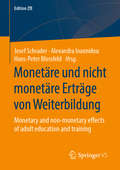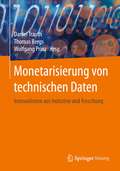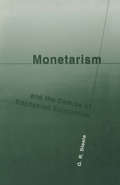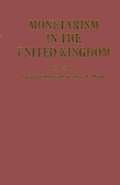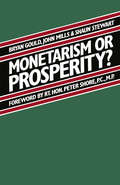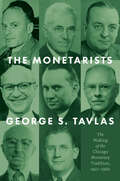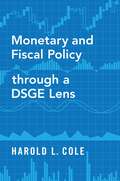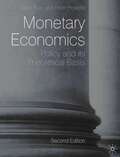- Table View
- List View
Monetäre und nicht monetäre Erträge von Weiterbildung: Monetary and non-monetary effects of adult education and training (Edition ZfE #7)
Im Zentrum des Bandes stehen monetäre und nicht-monetäre Erträge von Weiterbildung, die sich auf dem Arbeitsmarkt, im Einkommen oder auch im zivilgesellschaftlichen Engagement zeigen. Trotz der thematischen und institutionellen Vielfalt der Weiterbildung und der Unterschiedlichkeit der damit einhergehenden Erwartungen stellen sich die Autorinnen und Autoren der Herausforderung, kausale Wirkungszusammenhänge zu identifizieren. Impulse dafür bietet der Vergleich der vorgestellten internationalen Analysen.
Monetarisierung von technischen Daten: Innovationen aus Industrie und Forschung
by Daniel Trauth Thomas Bergs Wolfgang PrinzDie Monetarisierung von Daten ist per se ein sehr junges Thema, zu dem es nur sehr vereinzelt Fallbeispiele gibt. Es fehlt an einer Strategie bzw. einem Konzept, das Führungskräften den Weg in die Monetarisierung von Daten zeigt, insbesondere jenen, die die Digitale Transformation bzw. Industrie 4.0 für sich entdeckt haben oder davon bedroht sind. Weil Maschinendaten meist unstrukturiert und ohne Domänenwissen/Metadaten nicht verwertbar sind, birgt die Monetarisierung von Maschinendaten ein noch nicht abschließend bewertbares Potenzial. Um dieses Potenzial greifbar zu machen, werden in diesem Werk neben Beiträgen aus der Wissenschaft auch Praxisbeispiele aus der Industrie beschrieben. Anhand von unterschiedlichen Beispielen aus diversen Branchen kann der Leser bereits heute Teil einer zukünftigen Datenökonomie werden. Mehrwerte und Nutzen werden konkret beschrieben.
Monetarism and the Demise of Keynesian Economics
by G.R. SteeleAn examination of the role of money in a dynamic economy within the context of theoretical developments both within and in opposition to, the Quantity Theory tradition. Emphasis is on the dangers of basing economic policy on macroeconomic analysis.
The Monetarists: The Making of the Chicago Monetary Tradition, 1927–1960
by George S. TavlasAn essential origin story of modern society’s most influential economic doctrine. The Chicago School of economic thought has been subject to endless generalizations—and mischaracterizations—in contemporary debate. What is often portrayed as a monolithic obsession with markets is, in fact, a nuanced set of economic theories born from decades of research and debate. The Monetarists is a deeply researched history of the monetary policies—and personalities—that codified the Chicago School of monetary thought from the 1930s through the 1960s. These policies can be characterized broadly as monetarism: the belief that prices and interest rates can be kept stable by controlling the amount of money in circulation. As economist George S. Tavlas makes clear, these ideas were more than just the legacy of Milton Friedman; they were a tradition in theory brought forth by a crucible of minds and debates throughout campus. Through unprecedented mining of archival material, The Monetarists offers the first complete history of one of the twentieth century’s most formative intellectual periods and places. It promises to elevate our understanding of this doctrine and its origins for generations to come.
Monetary Analysis at Central Banks
by David CobhamWhatever happened to the money supply? This book explains how the analysis of monetary and credit aggregates is undertaken at the Bank of England, the European Central Bank and (as an example of a developing country) the Bank of Tanzania. The book also explores how this analysis relates to these central banks' monetary policy strategies and how it feeds into policymaking. An editorial introduction provides the intellectual and historical background – from the contributions of key economists such as Milton Friedman and Jacques Polak, to monetary targeting and inflation targeting – and argues that central banks and policy analysts would be foolish to neglect the insights monetary analysis can offer. The papers compiled in Monetary Analysis at Central Banks demonstrate just how useful and varied those insights are.
Monetary and Exchange Rate Policy (Studies in Banking and International Finance)
by Donald R. Hodgman Geoffrey E. WoodMonetary and exchange rate policies of national monetary authorities, together with certain of their consequences, provide the common theme for the studies in this volume. Four of the contributions are mainly concerned with exchange rate policy-decisions to alter fixed parities, intervention by central banks in foreign exchange markets, and the determinants of exchange rates including intervention and the degree of capital mobility. Two studies are oriented to aspects of domestic monetary policy, one examining policy reactions of French monetary authorities, the other concerning the choice of monetary aggregate target as a politically motivated strategy to assign responsibility for macroeconomic outcomes and thus influence the behaviour of decision makers in the macroeconomic policy making process. One contribution investigates the factors that influence the choice of currency in foreign trade, an important factor in determining the importance for exchange market stability of capital movements, and perhaps official intervention. The studies present significant theoretical and empirical results as well as the institutional material.
Monetary and Financial Cooperation in East Asia: The State of Affairs After the Global and European Crises
by Masahiro Kawai Yung Chul Park Charles WyploszThe global financial crisis and the Eurozone crisis have led to a profound rethink in East Asia about the international monetary system and regional monetary and financial integration. After the East Asian crisis of 1997, deeper regional cooperation was seen as the way to avoid reliance on the IMF and the rest of the world. Steps were taken, but they were limited because of disagreements reflecting regional rivalries. Still, integration into the global financial system and Europe's regional process were seen as objectives to be adapted to East Asia, as detailed in an overview chapter. The crises have shaken this strategy but also revealed the pre-existing deep disagreements. This book presents contributions by scholars from different countries. Each one was invited to describe the vision of their policymakers. The traidtional rivalry between China and Japan, the region's largest economies, reveals Chinese confidence into its rising power and Japanese growing doubts about its ability to weigh on the debate. For opposite reasons, both display a declining interest into regional cooperation. Korea and the ASEAN countries do not wish to choose between the regional powers but remain attached to regional cooperation and integration. They look for pragmatic solutions that recognize the value-chain characteristic of trade. Additional contributions by US and European scholars provide evaluations of the global and Eurozone crises and of their relevance for East Asian integration.
Monetary and Financial Policy in the Euro Area: An Introduction (Springer Texts in Business and Economics)
by Maximilian FandlThis textbook provides a comprehensive overview of monetary policy, banking supervision and financial stability in the euro area. The author uses his professional experience in central banking to provide a thorough understanding of European economics and to explore how the monetary and financial system functions. The book takes into account the profound changes that resulted from crisis developments in recent years, such as the implementation of quantitative easing or the establishment of the Single Supervisory Mechanism (SSM). The author also invites readers to develop their thoughts on alternative policies to shape the monetary and financial system of the future. The textbook is tailor-made for intermediate courses in economics but will also appeal to those preparing a career in central banking or financial regulation.
Monetary and Financial Systems in Africa: Integration and Economic Performance
by Aloysius Ajab Amin Regina Nsang Tawah Augustin NtembeThis book provides an overview of the monetary and financial systems seen in Africa. The issues related to these systems are examined to help evaluate their effectiveness in fostering the development of African economies. Economic integration is extensively discussed to highlight variations between different parts of Africa and the specific challenges seen within certain regions. The impact of monetary unions, in particular the CFA franc zone, on economic activities is also explored.This book aims to outline how sustainable development can be achieved in Africa through well-developed financial and monetary institutions and policies. It will be relevant to students, academics and policy makers interested in African and development economics.
Monetary and Fiscal Dynamics (Studies in Contemporary Economics)
by Michael CarlbergThe analysis will be conducted within an IS-LM model augmen- ted by the dynamics of money wages, private capital and public debt. A macroeconomic shock induces an extended process of adjustment that is characterized by unemployment. This in turn requires a dynamic path of monetary and fiscal policy: As a response to the shock, the central bank continuouslyadapts the quantity of money so as to keep up full employment all the time. And the government continuously accommodates its purchases of goods and services. Can this be sustained? Or will public debt tend to explode, thereby driving the stock of capial down to zero?
A Monetary and Fiscal History of the United States, 1961–2021
by Alan S. BlinderFrom the New York Times bestselling author, the fascinating story of U.S. economic policy from Kennedy to Biden—filled with lessons for todayIn this book, Alan Blinder, one of the world’s most influential economists and one of the field’s best writers, draws on his deep firsthand experience to provide an authoritative account of sixty years of monetary and fiscal policy in the United States. Spanning twelve presidents, from John F. Kennedy to Joe Biden, and eight Federal Reserve chairs, from William McChesney Martin to Jerome Powell, this is an insider’s story of macroeconomic policy that hasn’t been told before—one that is a pleasure to read, and as interesting as it is important.Focusing on the most significant developments and long-term changes, Blinder traces the highs and lows of monetary and fiscal policy, which have by turns cooperated and clashed through many recessions and several long booms over the past six decades. From the fiscal policy of Kennedy’s New Frontier to Biden’s responses to the pandemic, the book takes readers through the stagflation of the 1970s, the conquest of inflation under Jimmy Carter and Paul Volcker, the rise of Reaganomics, and the bubbles of the 2000s before bringing the story up through recent events—including the financial crisis, the Great Recession, and monetary policy during COVID-19.A lively and concise narrative that is sure to become a classic, A Monetary and Fiscal History of the United States, 1961–2021 is filled with vital lessons for anyone who wants to better understand where the economy has been—and where it might be headed.
Monetary and Fiscal Policies in the Euro Area
by Michael CarlbergThis book studies the interactions between monetary and fiscal poUcies in the euro area. It carefully discusses the process of policy competition and the structure of policy cooperation. As to policy competition, the focus is on competition between the European central bank, the American central bank, the German government, and the French government. As to policy cooperation, the focus is on the same institutions. These are higher-dimensional issues. The pohcy targets are price stability and full employment. The policy makers follow co- turkey or gradualist strategies. The policy decisions are taken sequentially or simultaneously. Monetary and fiscal policies have spillover effects. Special features of this book are numerical simulations of policy competition and numerical solutions to policy cooperation. The present book is part of a larger research project on European Monetary Union, see the references at the back of the book. Some parts of this project were presented at the World Congress of the International Economic Association. Other parts were presented at the International Conference on Macroeconomic Analysis, at the International Institute of Public Finance, at the Macro Study Group of the German Economic Association, at the Annual Meeting of the Austrian Economic Association, at the Gottingen Workshop on International Economics, at the Halle Workshop on Monetary Economics, at the Research Seminar on Macroeconomics in Freiburg, and at the Passau Workshop on International Economics.
Monetary and Fiscal Policy in an Integrated Europe (European and Transatlantic Studies)
by Barry Eichengreen Jeffry Frieden Jürgen V. HagenIn this volume, a group of distinguished economists and political scientists analyze the political economy of European integration, evaluating recent developments in European monetary and fiscal policy. They consider the current situation, as well as the prospects for an Integrated Europe. The book is unique in combining perspectives from economics and political science and provides an in-depth analysis of the new European institutions. The book will be of great interest to observers, scholars, and students of European economic and political affairs, macroeconomic policy, institutional analysis, and comparative and international political economy. Published in conjunction with "Politics and Institutions in an Integrated Europe" by the same editors.
Monetary and Fiscal Policy, the Exchange Rate and Foreign Wealth
by Patrizio TirelliThe book investigates issues of policy design in open economies. The performance of simple alternative policy rules is analysed in the context of theoretical models using both analytical solutions and numerical simulations techniques. One of the substantive contributions of the research is that policy evaluation should take into account, among other things, the implications of different rules for foreign wealth and the exchange rate. Hence the open economy models presented in the book include wealth effects and the current account.
Monetary and Fiscal Policy through a DSGE Lens
by Harold L. ColeIn Monetary and Fiscal Policy Through a DSGE Lens, Harold L. Cole develops and extends versions of a classic quantitative model of economic growth to take on a wide range of topics in monetary and fiscal policy. Bridging the gap between current undergraduate and graduate texts in the field, this comprehensive book covers the basic elements of advanced macroeconomics and equips readers to understand the debate on key policy questions. By using the simple DSGE, or dynamic stochastic general equilibrium, framework to build a series of quantitative models, the book combines a gradual introduction to advanced analytic methods with computer programming and quantitative policy analysis. In a clear discussion of the sophisticated interaction between theory and data, Cole explains how to gauge how well a model captures key elements in the data and how to reverse engineer a model to data. The book covers costs of inflation, optimal monetary policy, the impact of labor and capital taxes, and optimal fiscal policy. It systematically discusses technical material including the new Keynesian liquidity shock models, standard analytic methods, such as Lagrangian methods, and computational methods using Matlab and Python. With a strong computational emphasis, the volume teaches how to program up and solve systems of non-linear equations and develop models to study the macroeconomy. Knowing how to deeply understand and analyze models and develop computational code to evaluate the implications of those models is essential for students of macroeconomics. This book connects the standard undergraduate material to the elaborate models of advanced graduate courses with systematic and logical coverage of the basics of advanced modern macroeconomics.
Monetary and Fiscal Strategies in the World Economy
by Michael CarlbergThis book studies the strategic interactions between monetary and fiscal policies in the world economy. The world economy consists of two regions, say Europe and America. The policy makers are the central banks and the governments. The policy targets are low inflation, low unemployment, and low structural deficits. There are demand shocks, supply shocks, and mixed shocks. There are regional shocks and common shocks. This book develops a series of basic, intermediate, and more advanced models. Here the focus is on the Nash equilibrium. The key questions are: Given a shock, can policy interactions reduce the existing loss? And to what extent can they do so? Another topical issue is policy cooperation. To illustrate all of this there are a lot of numerical examples. The present book is part of a larger research project on European Monetary Union, see the references given at the back of the book. Some parts of this project were presented at the World Congress of the International Economic Association, at the International Conference on Macroeconomic Analysis, at the International Institute of Public Finance, and at the International Atlantic Economic Conference. Other parts were presented at the Macro Study Group of the German Economic Association, at the Annual Meeting of the Austrian Economic Association, at the Göttingen Workshop on International Economics, at the Halle Workshop on Monetary Economics, at the Research Seminar on Macroeconomics in Freiburg, at the Research Seminar on Economics in Kassel, and at the Passau Workshop on International Economics.
Monetary and Wage Policies in the Euro Area
by Michael CarlbergThis book studies interactions between monetary and wage policies in the Euro area, closely reviewing and discussing the process of policy competition and the structure of policy cooperation. On policy competition, the book focuses on competition between the European central bank, the American central bank, the German labour union, and the French labour union. As to policy cooperation, the focus is on the same institutions. Includes numerical simulations and solutions.
Monetary Conditions for Economic Recovery (Financial and Monetary Policy Studies #11)
by C. Van Ewijk J. J. KlantAn international symposium on Monetary Conditions for Economic Recovery was organised in Amsterdam from 14-16 November 1984 by the Department of Macroeconomics, Faculty of Economics of the University of Amsterdam, to honour its distinguished member, Professor G. A. Kessler, who had recently retired from his Chair of Monetary Econo mics. Experts on monetary theory and monetary policy from various parts of the world took part in the discussions on both the theoretical and practical aspects of the theme. The papers have been collected in this volume. Our debts in organizing the symposium and preparing this volume for publication are many. The symposium was financed through the support of a number of sponsors whose names have been listed on the next page. The Netherlands Bank accommodated the conference sessions. The organizing Committee owes much to the successful efforts of its members Jean Morreau, Casper van Ewijk and Annette Deckers. We are grateful to the President of the Netherlands Bank for his intro ductory speech on the work of Professor Kessler, which is included in this volume. Wouter Zant assisted in editing the volume for publication.
Monetary Divergence: Domestic Policy Autonomy in the Post-Bretton Woods Era (Michigan Studies In International Political Economy)
by David Bearce"In a meticulously researched study, David Bearce demonstrates that, contrary to predictions, financial globalization has not resulted in a systematic convergence of national monetary policies. The book is a must-read for students of the political economy of international finance. Highlighting the critical role of partisan politics in determining policy outcomes, Bearce adds a new and important dimension to our understanding of the impacts of international capital mobility in the contemporary era." —Benjamin Jerry Cohen, University of California, Santa Barbara "Bearce offers a compelling analysis of partisan economic policy in an open economy. By analyzing both fiscal and monetary policies, Bearce extends our understanding of how the electoral imperative conditions policy behavior. His conclusions will have to be addressed in any future debate about the topic." —William Bernhard, University of Illinois at Urbana-Champaign "Interest group divisions over exchange rates and macroeconomic policy have been at the center of international political economy research for about 20 years. Political scientists have studied these cleavages, focusing on the policy interests of various industry groups. On a separate but parallel track, another group of researchers explored the relationship between partisan politics and macroeconomic policy choices. In this exceptionally well researched book, Bearce integrates these two analytical traditions. Noting that industry groups are typically important organized constituents in left-wing and right-wing political parties, Bearce demonstrates how macroeconomic policy outcomes in advanced countries vary systematically with the alternation of political parties in government." —J. Lawrence Broz, University of California, San Diego David H. Bearce is Assistant Professor of Political Science at the University of Pittsburgh.
Monetary Economics: Policy and its Theoretical Basis
by Keith Bain Peter HowellsThis fully revised second edition of Bain and Howells' Monetary Economics provides an up-to-date examination of monetary policy as it is practised and the theory underlying it. The authors link the conduct of monetary policy to the IS/PC/MR model and extend this further through the addition of a simple model of the banking sector. They demonstrate why monetary policy is central to the management of a modern economy, showing how it might have lasting effects on real variables, and look at how the current economic crisis has weakened the ability of policymakers to influence aggregate demand through the structure of interest rates. The second edition: features a realistic account of the conduct of monetary policy when the money supply is endogenous provides a detailed and up-to-date account of the conduct of monetary policy and links this explicitly to a framework for teaching macroeconomics includes recent changes in money market operations and an examination of the problems posed for monetary policy by the recent financial crisisMonetary Economics is an ideal core textbook for advanced undergraduate modules in monetary economics and monetary theory and policy.
